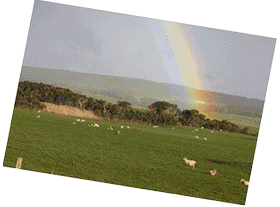The Farmers and the Winemaker Dinner Part 2 - Gippsland Food Adventures
Main menu:
Asparagus season
Just before leaving Gippsland on the way to Melbourne is the famous Koo Wee Rup swamp district. In the early days it represented an impenetrable barrier to travellers, but once drainage works started in the 1870’s, attempts were made to farm the area. The largest landholders in these early days were Scottish and may have believed that the swamp soils were favourable for farming, based on their knowledge of peaty soils in their mother country. In the first decade of the 1900’s the swamp became the "potato capital" of Victoria Over the years there have been many land use changes and many flood events and agricultural losses.
But these days, the Koo Wee Rup and Dalmore district produces over 90% of Australia’s asparagus – thanks due to the beautiful peat soils of the region. After years of driving through the asparagus fields on my way to Melbourne, I visited Deep Creek Organics farm last week to get a better appreciation of how those beautiful greens spears are grown. The property has been in the Bombaci family since the late 50’s and currently owned by Donna and Frank Bombaci. It is situated between Koo Wee Rup and Cardinia, along what the locals call "the golden mile" -
The Bombaci family grow (and have grown) other vegetables – zucchini, broccoli, beetroot, corn, tomatoes, but I got the sense that asparagus is their favourite, and quality is of critical importance. They used to supply the local large packing sheds with their asparagus, but due to very low margins, shifted to an organic production system to develop a niche market for their produce. They now do their own packing and market their produce through a wholesaler, but also offer farm gate sales and sell through the Paddlewheel store at Koonwarra and Prahran market.
The green asparagus are the shoots that grow up from crowns buried in the soil. From September to Christmas these shoots appear on a daily basis, with temperature having a direct impact on production – they say you can watch them grow on a really hot day! So it’s no surprise that this cool and cloudy spring has been very disappointing, with production considerably down.
These crowns need to be carefully managed in their early years. In their first year they are picked for only 2 weeks, and then the plants are allowed to go to the fern stage, so as to send energy back into the crown for its development. Picking time increase incrementally until the 4 th year when the full harvest of 14-
When I visited at lunchtime, all the harvesting and processing activity had been completed for the day on their farm. Harvesting is hard work, with pickers walking the rows early in the morning (wearing head lamps) and cutting the spears at 8-
Once picked and stacked in heaps, the asparagus is collected from the paddock, 
And the next morning the pickers walk down the same rows and the whole process starts again. Growth and yields fluctuate daily according to the weather, and with a short storage life, growers are exposed to potential market gluts and price falls.
So how do we eat these gems?
Donna barbeques the premium thick stems, or sometimes cooks them in a frypan with a little water and olive oil, also adding some chilli. The thin spears she cuts into shorter lengths and adds to an egg and milk mixture for omelettes. Me? I love to simply roast them in the oven with a splash of olive oil, served perhaps with shavings of parmesan.
Anyway, enjoy this quality Gippsland produce while the season lasts.
You can contact Donna and Frank on 59971167 or 0418378298 to arrange farm gate purchases.
